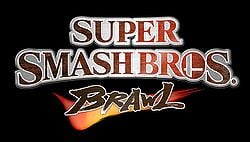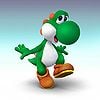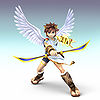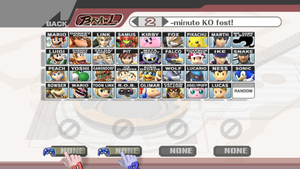Super Smash Bros. Brawl: Difference between revisions
mNo edit summary |
No edit summary |
||
| Line 112: | Line 112: | ||
===Bosses=== | ===Bosses=== | ||
[[File:Character Selection - Super Smash Bros. Brawl.png|thumb|right| | [[File:Character Selection - Super Smash Bros. Brawl.png|thumb|right|300px|The character-selection screen of ''Super Smash Bros. Brawl'' (all characters unlocked).]] | ||
{|class="wikitable" style="text-align:left;margin:1em auto 1em auto;" | {|class="wikitable" style="text-align:left;margin:1em auto 1em auto;" | ||
Revision as of 22:19, November 18, 2013
| “ | They're back. Stronger than ever. And they brought friends. Lots of them. | ” |
| —North American commercial | ||
| Super Smash Bros. Brawl | |
|---|---|
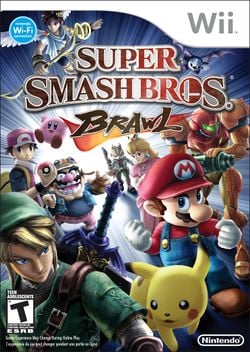 USA box art for Super Smash Bros. Brawl. | |
| Developer(s) | Sora HAL Laboratory Game Arts Monolith Soft Paon Intelligent Systems |
| Publisher(s) | Nintendo |
| Designer(s) | Masahiro Sakurai (director) Kazushige Nojima (scenario writer)[1] |
| Engine | Havok |
| Released | |
| Genre(s) | Fighting, Platform |
| Mode(s) | Single player, Multiplayer, Online multiplayer[5] |
| Ratings | CERO: A ESRB: T OFLC: PG PEGI: 12+ |
| Media | Wii Optical Disc (Double-layer) |
| System requirements | 128 free blocks of memory in the Wii System Memory |
| Input methods | Wii Remote, Nunchuk, Classic Controller, GameCube controller[6] |
- "Brawl" redirects here. For the game mode, see Versus Mode.
Super Smash Bros. Brawl, known in Japan as Dairantou[7] Smash Brothers X (大乱闘スマッシュブラザーズX, Dairantō Sumasshu Burazāzu Ekkusu), and often shortened to "SSBB" or "Brawl", is the third installment in the Super Smash Bros. series published by Nintendo. The game was designed by Masahiro Sakurai, who also created the two preceding Super Smash Bros. games, and was developed by an ad hoc development team consisting of Sora, Game Arts, and staff from other developers, beginning in October 2005. The game uses an engine called Havok provided by an Irish company of the same name.[8]
The object of a match in Super Smash Bros. Brawl is to knock the opponent off the screen and so beyond the "blast lines" which denote the field of battle; an emphasis on ring outs is standard for the series, but a departure from traditional fighting games which focus on knockouts. This departure continues in Brawl’s relatively simplified move commands, which can be input on four types of controller[6] - a Wii remote alone, the Wii remote and Nunchuk auxiliary controller, a Classic Controller/Classic Controller Pro, or a GameCube controller. Up to four players can engage in local multiplayer battles at any given time with any combination of controllers, while Brawl also supports online play through the Nintendo Wi-Fi Connection, the first game in the series to do so.[9]
However, while Brawl continues to include the tournament-like "Classic" and "All-Star" single-player modes, Melee’s Adventure Mode has been replaced with The Subspace Emissary; a more extensive side-scrolling beat-'em-up mode featuring both the playable characters and many enemies specifically created for the game. The resulting mode includes an involved plot, including numerous pre-rendered cutscenes, and some platform game elements during gameplay. Up to four players can play local multiplayer games using one of four sets of controllers.
Further following from the earlier games in the series, Brawl showcases a wide selection of characters from Nintendo and its second parties, setting them to fight in several different types of matches. Unlike its predecessors, however, Brawl also includes two third party characters in Solid Snake and Sonic the Hedgehog. In total, the number of playable characters was increased from Melee’s 26[10] to 35.[11]
Most of the game's musical score is made up of newly-arranged versions of pieces that originated in earlier video games starring the characters featured in Brawl; with the remainder taken directly from the original games. The new arrangements were composed in a collaboration between 38 renowned video game composers[12] and has been critically acclaimed for its representation of different generations in gaming history.[13]
The limited edition release of Super Smash Bros. Brawl came inside an extra cardboard sleeve depicting all of the characters available by default, and came with two postcards, providing a biopic on Zero Suit Samus and Zelda, giving a short summary of them, and showing images of their special moves.
Following the release of the game in Japan, a bug was discovered in the game. This bug causes the game to display an error message when it starts, however, players can close the error message and play the game as usual. There has since been a replacement program.
The game requires 128 free blocks of memory in the Wii System Memory. No data, except some vault data, can be copied to an SD Card or transferred onto another Wii. If the player does not create a save file when they start, he or she will not be able to play via Nintendo Wi-Fi Connection and vault data will not be saved.
Opening movie
In the opening movie of Super Smash Bros. Brawl, the cinematic utilizes scenes from the Subspace Emissary, along with a few selections of Vs. Mode matches, as opposed to featuring unique footage in the manner of the game's predecessors, Super Smash Bros. and Super Smash Bros. Melee.
<youtube>nfU48g3IUmY</youtube>
Characters
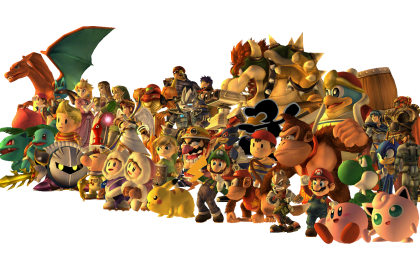
The cast of 35 playable characters (40 if Sheik and Zero Suit Samus are included and the three different Pokémon of the Pokémon Trainer are treated as individual characters alongside the Trainer) includes twenty returning veterans from Melee and fifteen newcomers. Of these, 21 are starter characters and fourteen need to be unlocked. Many of the returning characters have been updated or refined since their last appearance, either in terms of appearance, fighting capabilities, or both. For example, Link and Fox McCloud have taken on new designs from more recent titles, while Samus Aran has gained the ability to change into a new form, Zero Suit Samus, by using her Final Smash or by the player pressing a certain button after picking Samus and before picking a stage.
Five characters do not return from Melee, which are The Legend of Zelda's Young Link, Pokémon's Mewtwo and Pichu, Fire Emblem's Roy, and Mario universe's Dr. Mario. Outside the Mario series, these series gained new characters: for The Legend of Zelda, Toon Link was added; for Pokémon, Pokémon Trainer (who controls Charizard, Squirtle, and Ivysaur) and Lucario were added; and for Fire Emblem, Ike was added to the playable roster.
Several franchises already represented in the Super Smash Bros. series gain additional character slots, with the Kirby universe the biggest gainer, as both King Dedede and Meta Knight make their playable Super Smash Bros. debuts. Otherwise, EarthBound sees Lucas join, the Star Fox franchise adds Wolf, and the Donkey Kong universe, has Diddy Kong added to the roster; while Metroid has Samus' aforementioned "Zero Suit" form, which originally debuted in Metroid: Zero Mission, added as a transformation for its sole character.
New character slots which go to Nintendo series previously unrepresented include Pit, in the first appearance of elements from the Kid Icarus series in a video game since the 1991 Game Boy game Kid Icarus: Of Myths and Monsters; Wario, originally a Mario spin-off but long launched into a franchise of his own; Captain Olimar from the Pikmin series; and the NES peripheral R.O.B.
Finally, Solid Snake, the main protagonist of the Metal Gear franchise, and Sonic the Hedgehog from his eponymous series become the first third-party characters to appear in a Super Smash Bros. game.
List of characters
Bosses
Unplayable characters
Collectibles
The number of Trophies, statuettes of Nintendo characters and objects which can be collected in-game, was almost doubled from Melee. These trophies give a brief history or description, or both, of the character or objects they show.[14] A related feature was the introduction of stickers, small pieces of Nintendo artwork which can be picked up from offline and online matches, along with the Smash Service's "Spectator Mode." Stickers also make an appearance in the single-player and multiplayer modes, such as the Stadium mode. Stickers also act as a sort of enhancement to the characters' abilities when using attacks in Adventure Mode: The Subspace Emissary.[15]. Through the Trophy Hoard and Sticker Album, players can place trophies and stickers onto virtual backgrounds and take snapshots, all of which is recorded into the Wii's internal hard drive or onto SD cards depending on the player's choosing. From this point, these virtual items can be sent to other players via Nintendo Wi-Fi Connection, "WiiConnect24".[14][15]
The inclusion of a new Super Smash Bros. element, collectable CDs, which, when obtained, offer new music selections for playable stages. Although this can add more variety to the music played on a stage, the music selection will always be at random. However, the player can adjust how often a track can be played from the options menu. [16]
By completing stages in Classic Mode[17], All-Star Mode and The Subspace Emissary, coins can be earned. The coins can be used to play the Coin Launcher to win more stickers or trophies, to "pay" for Continues in Classic and All-Star Mode, to bet on the outcome of Spectator Mode matches and to choose stages in online play.
Masterpieces
Brawl introduces "Masterpieces", time-limited Virtual Console game demonstrations, to the Super Smash Bros. series. The international release has twelve such games available, each of which features one or more of the playable characters from Brawl. Seven games are available for play to begin with, with five more unlockable by completing Challenges, which range from Mario's debut in Donkey Kong to the critically acclaimed late Nintendo 64 title The Legend of Zelda: Ocarina of Time. The time-limits on each individual play last between 30 seconds (Donkey Kong), to five minutes (Ocarina of Time).
The Japanese release has two Masterpieces more than the international releases - the SNES games Mother 2 (known as EarthBound in its US release) and Fire Emblem: Monsho no Nazo.
Music
On May 22, 2007, Sakurai revealed a list of 38 composers providing the musical score for the game. In his accompanying statement, Sakurai said that he had asked the composers, who come from a variety of companies and have written music for first, second, and third-party games, "to listen to an elite selection of Nintendo music and arrange several of their favorite songs."[12]
Each of the game stages have multiple musical tracks which players can listen to using the new "My Music" feature, including some songs that were taken directly from other games without any modification or special arrangement. This feature also allows the player to adjust the frequency of how often a music track is played on a given stage. Collecting CDs expands the range of music available.[16]
Stages
Brawl features lots of stages that can be fought on. Most of them are new, but a few others come from Melee. On some stages, like Shadow Moses Island, Corneria and Lylat Cruise, Smash Taunts can be performed.
Brawl also has an option to create custom stages, the Stage Builder.
Development
At the pre-E3 2005 press conference, the president of Nintendo, Satoru Iwata, announced the next installment of Super Smash Bros. was not only already in development for their next gaming console, but would be a launch title with Wi-Fi compatibility for online play.[18] The announcement was unexpected to the creator of the Super Smash Bros. series, Masahiro Sakurai. Back in 2003, he had left HAL Laboratory, the company that was in charge with the franchises' development and was never informed of this announcement despite the fact shortly after resigning from the company, Iwata said if a new game was to be made, he would be in charge. It was not until after the conference Sakurai was called to Satoru Iwata's room on the top floor of a Los Angeles hotel where he was told by Iwata, "We'd like you to be involved in the production of the new Smash Bros., if possible near the level of director".[19] Although originally announced to be a launch title, Sakurai stated "I decided to become director. And as of May, 2005, I was the only member of the new Smash Bros. development team". Development of the game never actually started until late 2005, and just for its production, Nintendo opened a new office in Tokyo at the beginning of October 2005. Nintendo also enlisted outside help from a company who, at that point in time, just finished development of a major title. Sakurai also stated that these people had spent excessive amounts of time playing Melee. The team had access to all the original material and tools from the development of Melee, courtesy of HAL Laboratory.
Brawl was absent from Nintendo's Wii showing at its 2006 Pre-E3 press conference. The next day, on May 10, 2006, its first official trailer was unveiled at E3 and at the After-Hours Press Conference, Nintendo officially revealed the game under the name of Super Smash Bros. Brawl. In an interview with IGN, Sakurai said the Wii's motion sensing features might not be included because, "we found that trying to implement too much motion-sensory functionality can get in the way of the game."[20] As far as Wi-Fi play is concerned, Sakurai stated his plan was to include Wi-Fi connection compatibility and online functionality, he goes on to say "one of the primary reasons Super Smash Bros. Brawl was created was that Nintendo, when taking Wii online, wanted to have Smash Bros. to do that".[20] However, as stated on the Japanese version of the Smash Bros. website, "there would be many hurdles to cross," and an online ranking system is unlikely to be implemented.[21] During a test play between Sakurai and Hideo Kojima, creator of the Metal Gear series, Kojima stated that the game felt complete and that Nintendo "could put it out right now and it would sell millions of copies."[22] Starting May 22, 2007, the site had updates every weekday until shortly after Brawl's release. Throughout October 18-22, 2007 at the first Entertainment for All Expo show in Los Angeles, California, Nintendo hosted a Super Smash Bros. Brawl tournament.[23]
At the Nintendo Media Conference at E3 2007, it was announced by Nintendo of America president Reggie Fils-Aime that Brawl would be released on December 3, 2007 in the Americas.[24] However, just two months before its anticipated December release, the development team asked for more time to work on the game. During the Nintendo Conference on October 10, 2007, Nintendo of Japan president Iwata announced the delay, saying:
| “ | In order to fine tune Smash Bros., with this unprecedented game depth, we have decided that we have to take a little more time to complete the game than we announced before. We are sorry for the fans that are already anxiously waiting for the launch, but we would like to launch this game on January 24th, 2008 in Japan. As for the North American launch, we will review that too, and our local subsidiaries will make their own announcements.[25] | ” |
On October 11, 2007, George Harrison of Nintendo of America announced that Brawl would be released on February 10, 2008 in North America.[26] Apparently, the American English game was delayed again to March 9th. [27]
Inclusion of characters
Sakurai stated that he did not want to emphasize Japan-only characters;[28] in Brawl's cast, only Lucas had not appeared outside of Japan (although Marth had only previously only appeared internationally in Super Smash Bros. Melee, rather than his home franchise). Sakurai also stated there would be no more than three third-party characters;[28] these characters were Solid Snake and Sonic the Hedgehog. The inclusion of Konami-created character Solid Snake may seem to conflict with the Super Smash Bros. paradigm — to only include characters from games made by Nintendo and its second parties — but Sakurai said Hideo Kojima "practically begged" for Snake to be included in Melee, which did not happen because the game was too far in development. This in turn led to his appearance in the following game instead.[29] Similarly, Lucas from Mother 3 was intended to be used in Melee, but was left out because Mother 3 was delayed.[30]
Japanese fans were asked to submit their desired characters and musical themes via a forum on the game's official Japanese site, with some possibly appearing in the game. Likewise, fans from other countries were asked to submit ideas on Nintendo's official forums.[31]
Suggestions were no longer being taken as of June 9, 2006. In August 2006, Sakurai and Miyamoto stated that Nintendo was negotiating rights to other third-party characters.[32] The most requested third-party character, Sega's Sonic the Hedgehog, was announced to be in the game on October 10, 2007.[33]
Trailers
Several different trailers for Brawl were released before the game came out. The original trailer was shown at E3 2006 on May 11, 2006 and revealed Solid Snake as a playable character. A second trailer was shown at the Nintendo World 2006 convention in December, and revealed Fox's return as a playable character. A third trailer was shown at the October 10, 2007 Nintendo Press Conference, which revealed Sonic as a playable character. A final trailer showcasing Brawl's adventure mode, the Subspace Emissary, was released on Friday, December 21, 2007. This trailer revealed that Ike and the Ice Climbers would appear in this mode, among other things.
Reception
| Brawl reviews | |
|---|---|
| Publication | Score |
| 1UP.com | A[34] |
| Edge Magazine | 9 of 10[35] |
| Eurogamer | 9 of 10[36] |
| Famitsu | 40 of 40[37] |
| Gametrailers | 9.4 of 10[38] |
| IGN | 9.5 of 10[39] |
| NGamer | 93%[40] |
| Nintendo Power | 10 of 10[41] |
| Official Nintendo Magazine | 95%[42] |
| Compilations of multiple reviews | |
| Metacritic | 93% (81 reviews)[43] |
| Game Rankings | 92.84% (78 reviews)[44] |
| TopTenReviews | 3.85/4 (56 reviews)[45] |
| Awards | |
| Best Fighting Game[46] | |
Super Smash Bros. Brawl received critically positive reviews and sold successfully. In the United States, the game sold 874,000 units on launch day and 1.4 million units in its first week to become the fastest-selling video game in Nintendo of America's history, according to Nintendo. The game has sold 10.79 million units worldwide as of March 2012 according to Nintendo. Brawl currently holds an aggregate review score of 92.84% on Gamerankings and a score of 93% on Metacritic. It has reviews with ratings equal or slightly better than Melee. The game's multiplayer was received excellently, but single player, while noted as superior to Melee's, was still only average.
The game, however, has not gone without criticism. Many Melee players disliked some of the changes to gameplay in Brawl. Arguably the most controversial change is the added ability to act during hitstun, which reduces combo potential for characters. Other common complaints include the generally slower pace of gameplay, the decreased falling speeds, the removal of mechanics such as L-canceling and wavedashing, and, on a more universal scale, the addition of tripping to Brawl. Because of these changes, and many others, many players consider Melee to be a better game than Brawl, and there is contentious debate in the community over which game is superior.
Changes from Melee to Brawl
The most prominent Brawl-Melee change is the new physics. Because of these changed game physics, some consider Melee to be superior to Brawl. Others disagree, considering Brawl to simply have a different play style, as well as smoother gameplay.
- Generally, the game plays slower - every veteran has a slower falling speed, L-cancelling has been removed, and characters must wait a slight amount of time before being able to meteor cancel.
- The air dodge does not involve characters shifting in a direction; instead, characters continue on whatever path they were moving before the air dodge. This allows air dodging to not put characters into a helpless state, and it also makes wavedashing impossible.
- Hitstun in Brawl is significantly decreased, and can be air dodged or attacked out of; this makes true combos almost nonexistent.
- Not all characters can meteor cancel by jumping.
- The window for dash-dancing is so small it loses almost all its usefulness.
- Tether recoveries are generally less useful than the wall-grappling they replaced.
- Characters must wait an amount of time before being able to move after grabbing an edge.
- Shieldstun has been drastically decreased, with an increased perfect shield window.
- It only takes 7 frames to shield drop, making the game more defensively-focused.
- There is a landing lag glitch on not all but several characters, that causes the character when they land to be inflicted with the landing lag of a helpless inducing special move, if they grabbed the edge during the move, or after using the move before landing.
Aside from the inclusion of the new characters, stages and items, there are various other changes, including:
- Spikes are no longer existent, as the trajectory range for what the game recognises as a meteor smash has been increased, and all attacks that have a downwards angle now fall into this range.
- All characters can meteor smash with the addition of the Footstool Jump.
- Characters can grab an edge with their back facing it, making recovery easier and more flexible, as well as lowering the effectiveness of attacks that turn the opponent around, such as Mario's Cape.
- Smash attacks are easier to angle, as the player can now just hold up or down during the forward smash to angle it.
- Characters can pummel faster.
- Some characters can crawl, while others can glide or wall cling, and every character can swim.
- Some characters have the dash attack canceled up smash that improves their approach.
- The Final Smash has been added.
- Some characters can grab-release others quite reliably.
- Moonwalking has been removed.
- CPUs generally gained an AI increase, but still have many exploitable flaws.
- Grabbing a character does not restore their midair jump(s).
- Short hopping is easier as characters are a bit slower at jumping.
- Smash Taunts do not end if the user flinches; they have to be KO'd to end it early.
- Up smashes can be performed while running, known as a Slide Smash.
- Characters can now pivot grab.
- Glancing blows no longer deal damage, and a few sparks will show up to indicate one.
- All characters now have three taunts instead of one, and have On-screen appearances, which return from the original Super Smash Bros..
- The shrinking sound is now the sound from Super Mario Bros. Also, shrinking and growing animations have been added for every character.
- Outside of the main game, players can build custom stages and save snapshots and replays.
- The Sound Test is now available at the start. However, certain sounds and music have to be unlocked.
- Melee's Adventure Mode has been replaced by The Subspace Emissary.
- Event matches have selectable difficulties.
- The Home-Run Contest puts a temporary shield around the platform.
- All of the above three modes can also be played in co-op, and players can also play online in various modes.
- In one-player game modes, the C-stick acts the same as in multiplayer modes: instead of zooming, it's used as the player has configurated it, the default function being Smash attacks.
Voice actors
- Eric Newsome - Bowser, Meta Knight
- Ryō Horikawa - Captain Falcon
- Shin'ichirō Miki - Charizard
- Katsumi Suzuki - Diddy Kong
- Takashi Nagasako - Donkey Kong
- Dex Manley - Falco
- Jim Walker - Fox
- Hironori Miyata - Ganondorf
- Sanae Kobayashi - Ice Climbers
- Jason Adkins - Ike
- Craig Blair - Ivysaur
- Rachael Lillis - Jigglypuff
- Masahiro Sakurai - King Dedede
- Makiko Ōmoto - Kirby, Ness
- Akira Sasanuma - Link
- Bill Rogers - Lucario
- Lani Minella - Lucas, Pit
- Charles Martinet - Mario, Luigi, Wario
- Hikaru Midorikawa - Marth
- Samantha Kelly - Peach
- Ikue Ōtani - Pikachu
- Michele Knotz - Pokémon Trainer, Squirtle
- David Hayter - Snake
- Jason Anthony Griffith - Sonic
- Sachi Matsumoto - Toon Link
- Jay Ward - Wolf
- Kazumi Totaka - Yoshi
- Jun Mizusawa - Zelda/Sheik
- Alésia Glidewell - Zero Suit Samus
Note: Mr. Game & Watch, Olimar, R.O.B., and Samus have no voices, and therefore, no voice actors. It was rumored that voice actor Jim Cummings voiced Bowser in this game, but this rumor was later proven false.
Gallery
Trivia
- Unlike Super Smash Bros. Melee, the international releases of Brawl do not provide Japanese audio or text options.
- The announcer does not yell the game's title at the title screen, in contrast to the previous games in the Super Smash Bros. series.
- The opening does not show unlockable characters until the player unlocks them, with four exceptions: Ness, Marth, Sonic and Snake.
- Some non-human characters (like Donkey Kong, Diddy Kong, and Bowser) use more realistic sounds, rather than the cartoonish sounds they make in their own games.
- The Brawl menu was designed almost identically to Kirby Air Ride, including the Challenges Checklist.
- The Wii remote speaker is used in only two instances:
- When a player selects a character, a sound clip of the character will be played through the Wii remote.
- After each microgame on WarioWare, Inc., a different sound effect will be heard depending on the player's performance
- Unlike most other Wii games, the game disc for this game has two layers instead of one. This is due to the size of the game data.
- Super Smash Bros. Brawl achieved the feat of becoming Nintendo's fastest selling game in the United States. On March 9th 2008, just the first day of its release in the US, it sold 874,000 copies.
- Super Smash Bros. Brawl became the best-selling fighting game of all time.
References
- ^ Sakurai, Masahiro. Iwata Asks: Super Smash Bros. Brawl (Transcript). Retrieved on 2008-04-11.
- ^ Super Smash Bros. Brawl at Nintendo Australia. Nintendo (2006-05-12). Retrieved on 2007-06-20.
- ^ Upcoming Nintendo titles for Wii and Nintendo DS across Europe. Nintendo-Europe. Retrieved on 2007-07-11.
- ^ "Look who is attending the Brawl!", Nintendo, 2007-10-10. Retrieved on 2007-10-10.
- ^ Wi-Fi Play. Smash Bros. DOJO!!. Smashbros.com (2007-09-18). Retrieved on 2007-09-18.
- ^ a b Four Kinds of Control. Smash Bros. DOJO!!. Smashbros.com (2007-06-08). Retrieved on 2007-06-08. Cite error: Invalid
<ref>tag; name "four control" defined multiple times with different content - ^ Dairantou = "Great Fray"
- ^ Sakurai, Masahiro. Foreword. Smash Bros. DOJO!! (Internet Archive). Retrieved on 2007-11-11.
- ^ Sakurai, Masahiro (2007-11-16). Wi-Fi Play. Smash Bros. DOJO!!. Retrieved on 2008-04-22.
- ^ 26 including Sheik as a separate character from Princess Zelda
- ^ 39 including Sheik & Zero Suit Samus separately from Zelda and Samus, and counting Squirtle, Ivysaur, & Charizard individually rather than grouped as Pokémon Trainer
- ^ a b Sakurai, Masahiro ("May 22 Tue. 2007"). The Musicians. Smash Bros. DOJO!!. Retrieved on 2011-01-16.
- ^ Hudak, Chris. Super Smash Bros. Brawl Review at Game Revolution – Hit me with your best shot.. Game Revolution. Retrieved on 2008-04-21.
- ^ a b Trophies. Smash Bros. DOJO!!. Smashbros.com (2007-09-24). Retrieved on 2007-10-24.
- ^ a b Stickers. Smash Bros. DOJO!!. Smashbros.com (2007-08-15). Retrieved on 2007-10-24.
- ^ a b My Music. Smash Bros. DOJO!!. Smashbros.com (2007-09-07). Retrieved on 2007-10-28.
- ^ Classic. Smash Bros. DOJO!!. Smashbros.com (2007-10-30). Retrieved on 2007-10-30.
- ^ Casamassina, Matt (2005-05-17). E3 2005: Smash Bros. For Revolution. IGN. Retrieved on 2006-05-03.
- ^ IGN Staff (2005-11-16). Smash Bros. Revolution Director Revealed. IGN. Retrieved on 2007-06-21.
- ^ a b Casamassina, Matt; Peer Schneider (2006-05-10). E3 2006: Super Smash Bros. Brawl. IGN. Retrieved on 2006-08-01.
- ^ Miller, Ross (2006-06-05). Sakurai reveals new Smash Bros. Brawl details. Joystiq. Retrieved on 2007-06-21.
- ^ Dormer, Dan (2007-04-27). Kojima's Played Super Smash Bros. Brawl. 1up.com. Retrieved on 2007-06-21.
- ^ Wirgler, Matthew (2007-10-09). Super Smash Bros. Brawl and Mario Galaxy Playable at E for All. Advance Media Network. Retrieved on 2007-10-21.
- ^ Casamassina, Matt (2007-07-11). Nintendo E3 2007 Press Conference. IGN. Retrieved on 2007-07-11.
- ^ Nintendo Conference Fall 2007 (mpg). E-news.co.jp (2007-10-10). Retrieved on 2007-10-11.
- ^ Smash Release Date Confirmed. Retrieved on 2007-10-14.
- ^ Brawl Delayed Again (2008-01-15).
- ^ a b Klepek, Patrick (2006-06-05). Super Smash Bros. Brawl Details. 1UP. Retrieved on 2007-09-13.
- ^ Mcwhertor, Michael (2006-05-11). E306: Super Smash Bros. Brawl Q&A. Kotaku. Retrieved on 2007-09-18.
- ^ 速報スマブラ拳: Ness (Japanese). Nintendo. Retrieved on 2007-10-21.
- ^ E3 2006: Fans Asked to Fill Smash Bros. Roster. IGN (2006-05-11). Retrieved on 2006-05-11.
- ^ Rushan S. (2006-08-17). Sakurai and Miyamoto Comment on Sonic's Popularity. Nintendo Wii News. QJ.NET. Retrieved on 2007-08-04. “Nintendo hopes that Snake's appearance in Super Smash Bros. Brawl will encourage other publishers to allow their characters to join the Smash Bros. line-up, and is already actively negotiating for the rights to include at least one other non-Nintendo character.”
- ^ Sonic The Hedgehog. Smash Bros. DOJO!!. Smashbros.com (2007-10-10). Retrieved on 2007-10-10.
- ^ Mielke, James (2008-03-07). Super Smash Bros. Brawl Review. 1UP.com. Retrieved on 2008-05-16.
- ^ Edge staff (April 2008). http://www.next-gen.biz/index.php?option=com_content&task=view&id=9575&Itemid=51 Super Smash Bros. Brawl Review, 84–85.
- ^ Bramwell, Tom. Eurogamer Super Smash Bros. Brawl Review. Eurogamer. Retrieved on 2008-03-27.
- ^ Gray, Brian. "Famitsu Gives Smash Bros. Brawl a Perfect Score", 1up.com, 2008-01-16. Retrieved on 2008-04-27.
- ^ GameTrailers Super Smash Bros. Brawl Review. GameTrailers. Retrieved on 2008-03-09.
- ^ Casamassina, Matt. IGN Super Smash Bros. Brawl Review. IGN. Retrieved on 2008-03-04.
- ^ Castle, Matthew. Ngamer — Review: Super Smash Bros. Brawl. NGamer. Retrieved on 2008-02-26.
- ^ Slate, Chris. "Simply Smashing", Nintendo Power, Future US, March 2008, pp. 82–83.
- ^ Mathers, Martin (2008-06-26). Wii Review: Super Smash Bros.. Official Nintendo Magazine. Retrieved on 2008-10-02.
- ^ Super Smash Bros. Brawl (wii: 2008): Reviews. Metacritic. Retrieved on 2008-04-23.
- ^ Super Smash Bros. Brawl Reviews. Game Rankings. Retrieved on 2010-10-25.
- ^ TopTenReviews – Super Smash Bros. Brawl. TopTenReviews. Retrieved on 2008-07-09.
- ^ Gamespot: Best Fighting Game of the Year. GameSpot. Retrieved on 2009-02-23.
External links
| Super Smash Bros. series | |
|---|---|
| Super Smash Bros. · Super Smash Bros. Melee · Super Smash Bros. Brawl · Super Smash Bros. 4 (for Nintendo 3DS · for Wii U) · Super Smash Bros. Ultimate |
| Super Smash Bros. Brawl menu items | |
|---|---|
| Group | Brawl (Time · Stock · Coin Battle · Team Battle) · Rules · Special Brawl · Rotation · Tourney · Names |
| Solo | Classic · All-Star · Adventure Mode: The Subspace Emissary · Events · Stadium (Target Smash!! · Home-Run Contest · Multi-Man Brawl · Boss Battles) · Training |
| Wi-Fi | Spectator Mode · With Anyone · With Friends |
| Vault | Trophies & Stickers (Trophy Gallery · Trophy Hoard · Coin Launcher · Sticker Album · Sticker Center) · Stage Builder · Album · Challenges · Replays · Masterpieces · Chronicle |
| Options | Screen · Deflicker · Rumble · Controls · Sound · My Music · Erase Data |
| Data | Movies · Records (Group Records · Brawl Records · Notices) · Sound Test |
